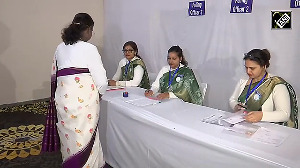Which of these statements is correct?
-
Chhattisgarh ranks fourth among states in terms of economic freedom; Punjab is 17th.
-
Punjab is fourth in terms of economic freedom; Chhattisgarh is 19th.
Answer: Both. It all depends on how you define economic freedom.
Two indices ranking Indian states for economic freedom -- both titled Economic Freedom Index for India (EFII) -- using different definitions, throw up some interesting results.
In the first index (EFII-1), economists Bibek Debroy, Shubashis Gangopadhyay and Laveesh Bhandari define economic freedom as an individual's unfettered ability to make economic choices unhindered by external forces, whether government or society.
Thus, they broaden the scope of economic freedom from the conventional definition relating to the absence of restrictions on and heavy-handed government presence in economic activity.
That's the definition used in a global economic freedom index (EFI) that ranks nations, pioneered by the Canada-based think-tank Fraser Institute, and another index used by the US-based Heritage Foundation.
The EFII-1 uses 50 measures, a mix of economic and social indicators, grouped into 13 categories:
-
The ability to make a choice (poverty levels, health indicators, type of houses, electricity and sanitation).
-
Social and family biases (sex and literacy ratios as well as caste differentials in education).
-
Lack of available choices (rate of economic growth, employment, work participation levels and so on).
-
Lack of information (access to newspapers, telephone, mobile phones and television).
-
Lack of physical mobility (access to roads, availability of buses and ownership of cars/two-wheelers).
-
Lack of ability to process information (access to education and teacher-pupil ratio).
-
Safety, law and justice.
-
Efficiency of governance.
-
Limits on trade (market fees, licence fees for traders, the number of haats/mandis and regulated markets).
-
Constraints on realising full returns from effort (basically, taxes).
-
Limits on control over own business (industrial relations scenario, power shortage).
-
Issues in buying and selling of land/assets (taxes on property and capital transactions, stamp duty rates and so on).
-
Availability and cost of capital.
"It's not about business environment or industries," says Bhandari. This index was constructed for the Rajiv Gandhi Institute for Contemporary Studies and has been published in a recently-released book, Agenda for Improving Governance, edited by Debroy.
Tamil Nadu tops the economic freedom charts in the EFII-1. Nipping at its heels is Maharashtra, followed closely by Gujarat, Punjab and Andhra Pradesh. No surprises there, clearly. Or, in the fact that Bihar occupies the 20th position.
Though Maharashtra is better placed in traditional economic freedom indicators (better industrial relations scenario; larger number of regulated and unregulated markets; lower tax-state domestic production), Tamil Nadu edges past to the top due of its social and governance indicators.
That's also roughly why the last (and now fallen) bastions of socialism in India -- Kerala and West Bengal -- are ranked so differently.
West Bengal has higher economic growth rate and lower state taxes, but its low work-participation rates and poor law and order situation pull it down. Kerala, in contrast, fares poorly on many economic indicators. However, its excellent social indicators put it among the top 10 economically-free states.
What happens when states are ranked according to the conventional definition? A just-completed but yet unpublished second sub-national index (EFII-2), a collaboration of the RGICS and German public policy organisation Friedrich Naumann Stiftung (FNSt), draws upon the Fraser Institute's index and classifies 26 indicators under three groups:
-
Size of government (government revenue expenditure, power subsidy, state-level taxes and government employment).
-
Legal structure and security of property rights (quality of legal infrastructure, completion of cases, violent crimes and economic offences).
-
Regulation of credit, labour and business (wage levels, man days lost, licence and market fees, implementation of industrial entrepreneur memorandums (IEMs) and so on).
This has Gujarat, Andhra Pradesh and Kerala on the first three rungs while Chhattisgarh ranks higher than Tamil Nadu and Maharashtra. The top five states in the EFII-2, barring Kerala, have small-size governments.
Tamil Nadu does well only in the second parameter, where it ranks first, followed by Madhya Pradesh, Kerala and Haryana. Surprisingly, the top five economically-free states fare average to poor in the third area, where Maharasthra leads, with Kashmir, Orissa and Jharkhand at its heels.
The two indices reflect the classic debate between positive (freedom to) and negative (freedom from) freedoms.
"The problem is that there is no agreement on what counts as positive freedom," says Parth J Shah, president, Centre for Civil Society, which partners the Fraser Institute in its EFI.
"The negative view of freedom is conceptually clearer and gives a more structured way of measuring freedom."
Economic freedom purists like Shah shudder at the inclusion of most of the components in the EFII-1, arguing that this really confuses freedom with development.
The EFII-1, however, counters that in India, family, community and social constraints are equally restrictive of individual freedom as state-imposed restrictions.
For example, it is pointless to say anyone is free to set up an enterprise anywhere if that freedom is curtailed by the lack of roads or power or social restrictions on women and those from the lower castes. Planning Commission Advisor N J Kurien, who has tracked states closely, tends to agree.
"States attracting massive investments are those with not only a favourable economic environment but physical and social infrastructure and good governance," he says.
Shah concedes the point about social and cultural practices hampering freedom. But he's justifiably worried that the inclusion of positive freedoms in the index may lead to the assumption that the government must provide these freedoms.
"That goes against the concept of a liberal form of government," he argues. Debroy doesn't quite agree. "Providing access to education does not necessarily mean that the government must provide education. Maybe some financing is necessary."
Both indices shatter a few myths. Kerala being in the top 10 in both boggles the mind. As does Uttaranchal and Kashmir ranking higher than Haryana in the EFII-1 and West Bengal being three notches above Punjab in the EFII-2. Explains Debroy: "Often perceptions are not substantiated by objective facts."
The problem is compounded by the lack of hard data on many issues. For example, labour market rigidities may be best captured by the number of applications filed by companies for retrenchment of workers (required under the Industrial Disputes Act), the number of approvals by state governments and the time taken for approvals.
However, this data is available for only five states, says Debroy. Similarly, ease of doing business is best reflected in the number of licences/clearances required by each state for setting up a business. But that's hard to capture as well.
Heterogeneous states with disparate inter-regional development fare poorly compared to homogeneous states where prosperity and poverty are more evenly distributed. That explains, says Debroy, the huge difference in rankings between Punjab and Haryana -- twin states for all practical purposes -- in both indices.
Both studies find that the more economically-free states are also more prosperous, but have shied away from arriving at any conclusions about causality -- whether economic freedom leads to stronger economies or whether stronger economies result in more economic freedom. "Purely from an academic point of view," says Debroy. To paraphrase that ad line for a toffee: the argument will continue.






 © 2025
© 2025